earlyphases
Project Phases
Phase I Accomplishment (Architectural Design):
Completed the initial architectural design of the system, including hardware and software components.
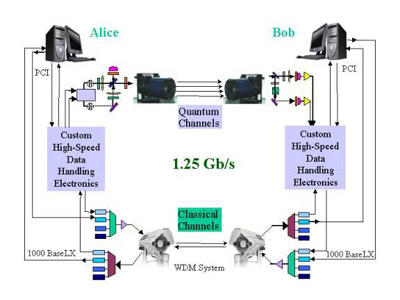
Architecture of NIST QuIN testbed
Phase II Accomplishments (Component Design and Implementation): A four-channel 1G Ethernet WDM system, and the optical interfaces to telescopes were completed. These classical channels are to be used for sending timing and framing information.
|
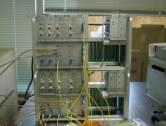 WDM for 125GHz classical system
|
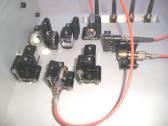 Optical interface for quantum links
|
The high-speed electronics for controlling the full system was designed and the circuit boards were fabricated. An FPGA on each board allows for complex parallel logic that is reprogrammable providing a path for revisions and enhancements.
|
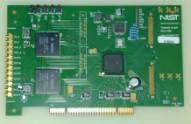 |
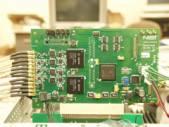 |
Completed the device drivers for the PCI boards which provide access to the hardware. Completed the basic upper layer software for system control and management of secrets (obtaining, maintaining, and using quantum keys), and interactions with applications that need encryption.
Phase III Accomplishments (System Integration and Performance Measurements):
We integrated the NIST custom high-speed electronics, which handles a large portion of the BB84 QKD protocol, to the Quantum devices and optics on the lower layers and to the communications software algorithms, Sifting and Error Reconciliation (Cascade) on the higher layers. Bring this highly experimental system to life required significant tuning and enhancements of all the layers of our testbed. An early indication of our success is the preliminary 1 Mb/s Sifted Key rate we were able to achieve from our initial integrated Testbed trails.
|
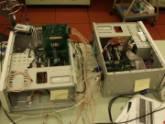 High Speed electronics communication using the QKD protocol stack Optical Network |
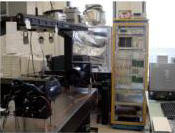 Optical Network – Quantum Channels and Classical channels |
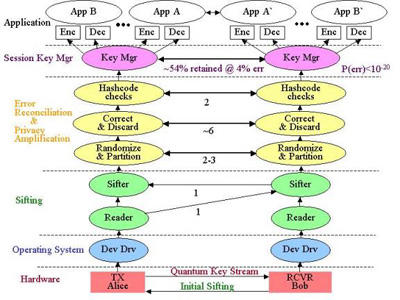
The QKD Protocol Stack
Phase IV Accomplishments (Enhancements & Fiber Development):
During 2005-2006 we have attained significant performance results with the development of a polarization encoded fiber-based QKD system. Initial performance for a B92 protocol implementation was measured in excess of 1 Mb/s Sifted Key rate, followed by a number enhancements performance was doubled to 2 Mb/s Sifted Key rate and 1 Mb/s Privacy Amplified secure key. After upgrading the system to conduct the BB84 protocol, performance was measured in excess of 4 Mb/s Sifted Key rate with an error rate of 3.6% over 1km of fiber. The technical details are described in the publication "Experimental Study of High Speed Polarization-Coding Quantum Key Distribution with Sifted-Key Rates Over Mbit/s," Optics Express, Vol. 14, No. 6, p.2062 (2006).
Furthermore, as part of its open testbed function, super conducting single photon detectors developed in NIST's EEEL were installed in place of the original silicon detectors and measured performance showed these detectors had very low jitter allowing high time resolution.
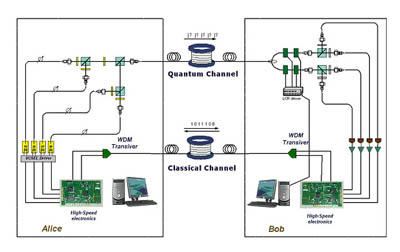
Fiber-based Quantum Key Distribution System
The figure above shows the configuration of the system. It uses two telecom fibers. One is the quantum channel for transmitting 850 nm photons with a mean photon number of 0.1. The other is the classical channel transmitting bi-directionally at 1510 and 1590 nm. Four silicon-based single photon detectors are used in the system. The NIST custom high-speed electronic printed circuit board handles the quantum and classical channels and the sifting protocol. The NIST reconciliation and privacy amplification protocols are currently implemented in software.
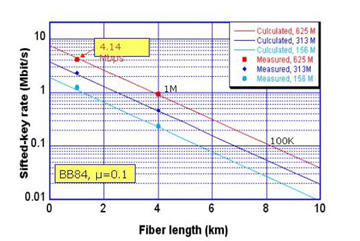
Sifted Key Rate vs. Distance
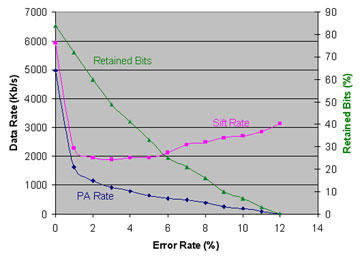
Data Rate vs. Error Rate
The system generates 4 Mbit/s of sifted key over 1km of fiber, and 1 Mbit/s over 4km. From calculation it should be able to generate sifted key at 0.1 Mbit/s over 8 km of fiber.
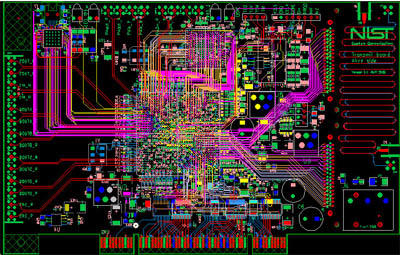
The next generation of high-speed electronics will provide faster QKD operation by using higher frequencies and incorporating reconciliation and privacy amplification in hardware.
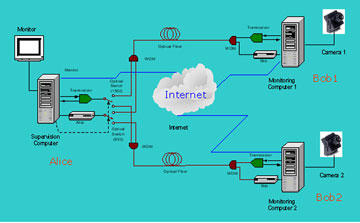
As an example of an application for our high speed QKD system, we are constructing a video surveillance network with three nodes, (one Alice & two Bobs). Alice can alternatively view QKD secured real-time video signals from either the cameras at Bob1 or at Bob2, which are at two different locations.
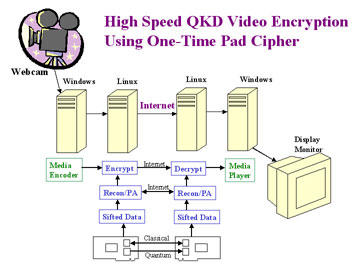
The NIST secure QKD video surveillance application encrypts, transmits and decrypts web quality video continuously over the internet using a continuously generated real-time QKD secure key.

